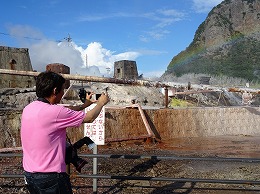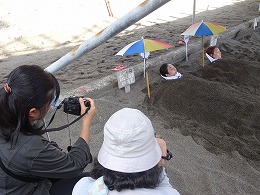実施日 : 2016年09月12日(月) - 14日(水)
Report: Kyushu (Kumamoto and Kagoshima) Press Tour
投稿日 : 2016年10月31日
In April, Kumamoto prefecture was struck by two large earthquakes (shindo 7 on the Japan Meteorological Agency seismic intensity scale). A press tour was held covering the current situation in Kumamoto prefecture as it works towards recovery from the earthquakes, as well as looking at initiatives in Ibusuki, Kagoshima, where residents live in harmony with the blessings of a volcano.
Ten journalists participated in this tour, from China, Germany, Hong Kong, Italy, South Korea, Taiwan, and the US.
-Click here for further details on the tour
-Click here for a log of real-time updates from during the tour
<Day 1>
1. Mashiki
The tour visited Mashiki, a town that was badly damaged in the earthquakes, where a town official acted as a guide to the group as they observed the damage from the earthquakes. Journalists asked the official questions including, “What will the reconstruction costs be for Mashiki as a whole,” and “Will the supplementary budget be enough to cover costs,” while photographing scenes such as cracks in the road and houses damaged or destroyed in the earthquakes.
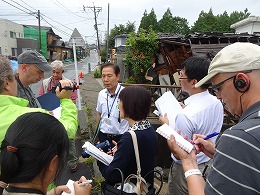
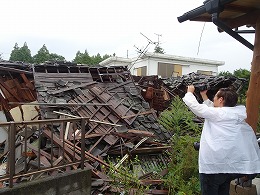
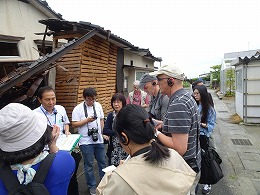
2. Minamiaso
(1) Interview with Mr. Hiroaki Morio, owner of Tinkna Pension
The bus stopped along National Route 299, which runs through Minamiaso village, and the journalists interviewed Mr. Hiroaki Morio, the owner of a pension, in front of his pension that was damaged in the earthquakes. Mr. Morio described in detail the situation when the two earthquakes occurred, and the journalists asked questions such as “How bad is the damage, and how much time and money will it take to repair the pension,” and “Do you plan to run a pension in Minamiaso again, or will you move somewhere else?” Mr. Morio described his feelings: “These earthquakes made me feel strongly that I want to run a pension for the rest of my working life. Although I have some worries about the future, I would like to reopen the pension as soon as possible and see guests’ happy faces.”
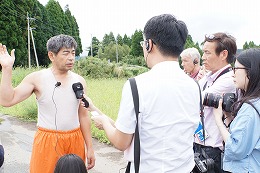
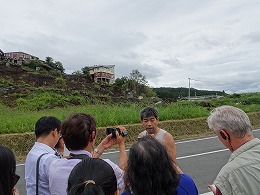
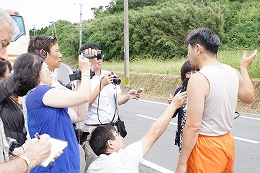
(2) Minamiaso Temporary Housing
The tour visited the temporary housing complex in Minamiaso Choyo Sports Park, and received a briefing on temporary housing in Minamiaso from a member of the Minamiaso Village Office Building Section, as well as interviewing residents of the temporary housing. Questions from journalists included, “Are there any issues with the earthquake resistance of the temporary housing,” and “Legally, people are allowed to live in temporary residences for up to two years, but how long do you think it will actually take until the temporary housing is no longer needed?”
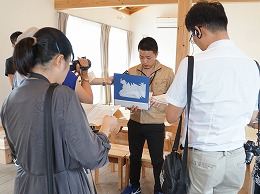


(3) Café Tippel
After the Kumamoto earthquakes, Mr. Hisao Koyama and his daughter have lent rooms at their pension to people working on the reconstruction, and reopened their café for business. The Koyama family visit Germany every year to buy ornaments for sale at the café, and the journalists asked, “Did you receive any aid from Germany,” and “Will there be any government subsidies for the repairs to the pension?”
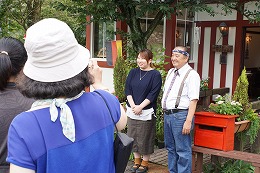
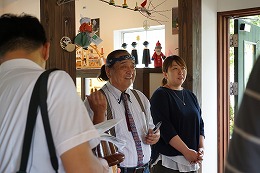
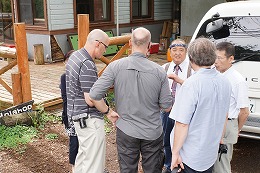
3. Aso Farm Land, Inc.
Upon arriving at Aso Farm Land, the tour was met by General Sales Manager Koji Masuda and Planning and Marketing Department Director Chizu Moriyama, before going to an observation deck where they could see the effects of landslides on the mountain caused by the earthquakes. The journalists then heard about the situation at the time of the earthquakes, and what led to Aso Farm Land housing evacuees. Questions included what points they were being careful about with evacuees staying in some of the Dome Houses, while at the same time the facility is open for business to tourists, and what effects there had been on tourists from overseas. The journalists showed a significant degree of interest in the Dome Houses, asking about the possibility of using the lightweight and earthquake-resistant Dome Houses for temporary housing, demand for Dome Houses overseas, the possibility of exports, and about new business opportunities.
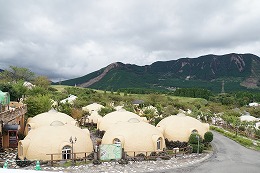
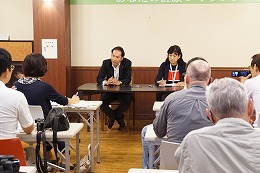
4. Asobougama
Mr. Futoshi Yamashita is a potter uses the volcanic soil of Aso in his work. When asked what piece he was particularly proud of, he responded by showing a clay pot he made symbolizing Mt. Aso and the Aso Caldera. While photographing and filming Mr. Yamashita as he worked on a piece, the journalists heard from him about what it was like when the earthquakes hit, and why he decided to become a potter.
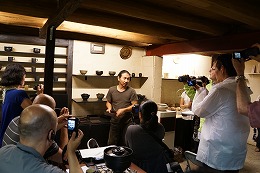
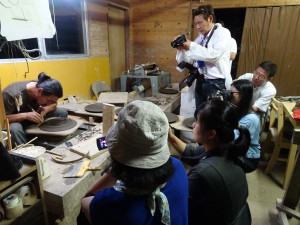
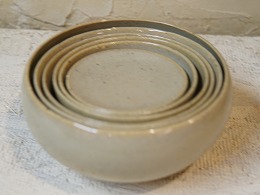
5. Aso Plaza Hotel
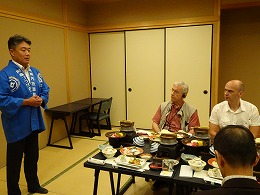 Mr. Junichi Inayoshi, president of Aso Plaza Hotel and chairman of the Aso Tourism Association, spoke about the effects of the Kumamoto earthquakes on the tourism industry and other facets of the local economy. Mr. Inayoshi noted that fortunately at least no tourists visiting Aso were injured in the earthquakes, and told the journalists that “There are rumors that Aso is dangerous so you shouldn’t go there, but Uchinomaki Onsen is still open for business as usual. I’m grateful that foreign tourists have returned to Aso so soon.”
Mr. Junichi Inayoshi, president of Aso Plaza Hotel and chairman of the Aso Tourism Association, spoke about the effects of the Kumamoto earthquakes on the tourism industry and other facets of the local economy. Mr. Inayoshi noted that fortunately at least no tourists visiting Aso were injured in the earthquakes, and told the journalists that “There are rumors that Aso is dangerous so you shouldn’t go there, but Uchinomaki Onsen is still open for business as usual. I’m grateful that foreign tourists have returned to Aso so soon.”
<Day 2>
6. Interview with Kumamoto Prefecture Governor Ikuo Kabashima
Governor Kabashima spoke about the current state of recovery and remaining issues, the lessons learned from the Kumamoto earthquakes, and aid from overseas. The governor mentioned how efforts were made to rapidly take action in line with what those affected by the disaster wanted, with the situation remaining in flux since the earthquakes, and stated the importance of initial response. The governor commented, “As recovery proceeds in earnest, I would like to minimize the pain of the people affected by the disaster, overcoming issues and carrying out a creative recovery for Kumamoto prefecture within my term.” After the interview, Kumamoto prefecture’s mascot character Kumamon also made an appearance
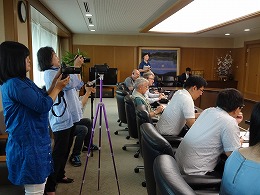
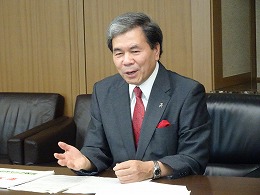
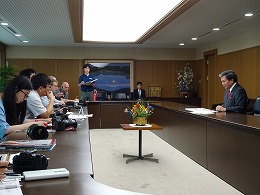
7. Kumamoto Castle
(1) Josaien
Josaien is an area near the castle where there are a number of restaurants and shops selling souvenirs. The journalists heard from members of the restaurant industry about the situation at the time of the earthquakes and the amount of customers since then. Questions included how many customers there were right after the Kumamoto earthquakes and the impact on Josaien’s sales, and the effects of the Visit Kyushu Special Campaign.
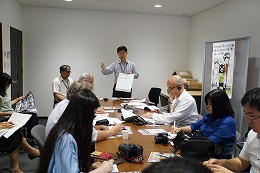
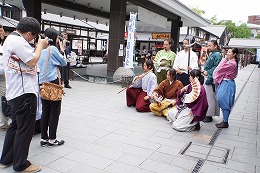
(2) Kumamoto Castle
With Mr. Yusuke Umeda of the Kumamoto Castle General Office acting as a guide, the tour visited Kumamoto Castle, which was badly damaged by the earthquakes and repeated aftershocks. While filming and photographing the current state of Kumamoto Castle, the journalists asked Mr. Umeda questions such as “When are all the repairs to the castle expected to be finished,” “Are there any plans to use the ‘joint castle owner’ system for repairs to Kumamoto Castle? Are you accepting donations from foreigners and people living overseas as well,” and “What were your feelings the first time you saw the castle after the earthquakes?” Some journalists filmed reports while standing in front of the damaged castle tower and collapsed stone wall. Mr. Umeda described his feelings at the time of the earthquakes: “I grew up looking at Kumamoto Castle. I came to check on it right after both earthquakes. When I saw the collapsed stone walls, I was at a loss for words.”
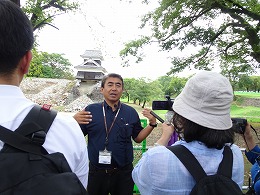
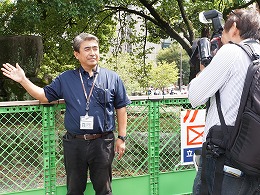
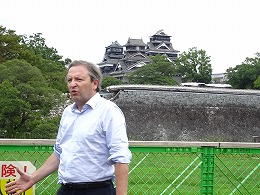
8. Briefing by Kyushu Tourism Promotion Organization and Ministry of Economy, Trade and Industry Kyushu Bureau of Economy, Trade and Industry
After travelling from Kumamoto Station to Ibusuki, Kagoshima on the Kyushu Shinkansen, the group received a briefing on the effects of the Kumamoto earthquakes on the economy and the road to recovery for Kyushu tourism. The briefers were Mr. Masaki Kawahara, head of the Ministry of Economy, Trade and Industry Kyushu Bureau of Economy, Trade and Industry Bilateral Investment Promotion Section, and Mr. Makoto Takahashi, executive director of the Kyushu Tourism Promotion Organization.
The journalists asked questions regarding numerous topics, including what the damages were to major Japanese automobile and electronics manufacturers with their production plants in Kyushu, the state of recovery of each industry, details of the Visit Kyushu Special Campaign and the target number of people for it, the national government’s economic stimulus policy using a second supplementary budget, and the effects of the Kumamoto earthquakes on tourists.
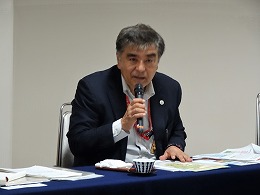
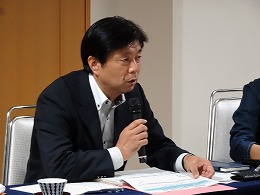
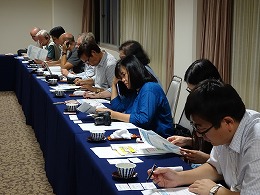
<Day 3>
9. Briefing by Ibusuki City Official 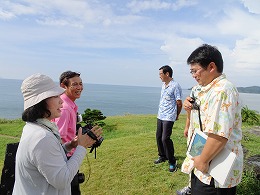
Mr. Kazunari Ueda of the Ibusuki City Industry and Fisheries Section and Mr. Hitoshi Kaji of the Ibusuki City Tourism Section gave an explanation of the unique features of, main industries, and tourism in Ibusuki, where they benefit from the bounty of a volcano. Questions included the number of tourists from China, Hong Kong, South Korea, and Taiwan, the amount of geothermal power generated, and why volcanic soil is good for growing sweet potatoes and okra.
10. Healthy Land Outdoor Bath Tamatebako Onsen
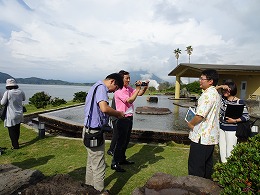 Tamatebako Onsen is an outdoor bath operated by Ibusuki City, which the tour visited before opening hours. Mr. Ueda from the Ibusuki City Office explained how the onsen became popular in Japan due to word of mouth, and that it now has 70,000 visitors annually.
Tamatebako Onsen is an outdoor bath operated by Ibusuki City, which the tour visited before opening hours. Mr. Ueda from the Ibusuki City Office explained how the onsen became popular in Japan due to word of mouth, and that it now has 70,000 visitors annually.
11. Ibusuki Shuzo
The tour visited Ibusuki Shuzo, a distillery that makes Satsuma shochu, and with director and plant manager Mr. Hiroyuki Kamikawadoko as a guide, observed the process of making Satsuma shochu, including processing the sweet potatoes and making rice malt. During the Q&A session, journalists asked about uses for the sweet potatoes left over from distilling, annual output of Satsuma shochu, the effects of the declining popularity of shochu and sake among Japanese youth, and the amount exported overseas.
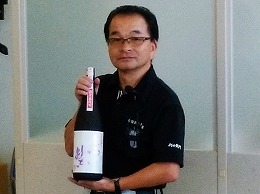
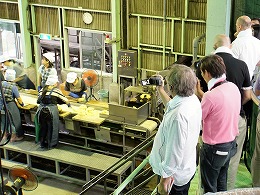
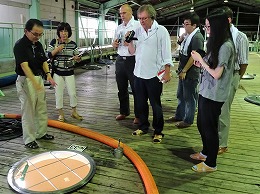
12. Imamura Aquaculture Co., Ltd.
The tour visited Imamura Aquaculture Co., Ltd., which uses hot springs water to farm eels. President Hironobu Imamura took the journalists around the facility, and responded to questions including “How much does using hot springs reduce costs,” “How long does it take from starting to farm an eel to shipping,” “Are hot springs suited to farming eels,” and “How much of an effect has the increasing price of baby eels had on your business?”
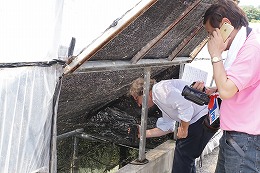
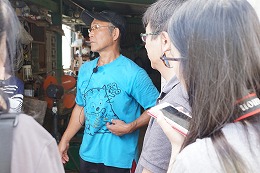
13. Sweet Potato Farm
The tour visited a farm that cultivates sweet potatoes used to make Satsuma shochu at Ibusuki Shuzo. While hearing about the features of volcanic soil that makes it suited to growing sweet potatoes, the journalists filmed and photographed as sweet potatoes were harvested.
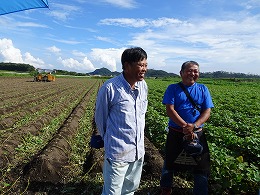
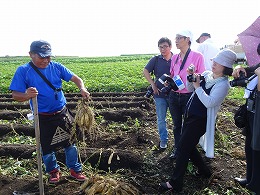
14. Hot Spring Steam Sand Bath and Former Site of Yamakawa Salt Farm
The three-day Kyushu press tour ended with visiting hot spring steam sand baths and the former site of Yamakawa Salt Farm. While filming and photographing the site of the former salt farm, where steam and hot springs still come up from underground, the group traveled to the beach where the hot spring steam sand baths are located. Mr. Ueda from the Ibusuki City Office gave an explanation of the effects of the hot spring steam sand baths, after which the journalists filmed and photographed the unique bathing method of people buried in sand.
